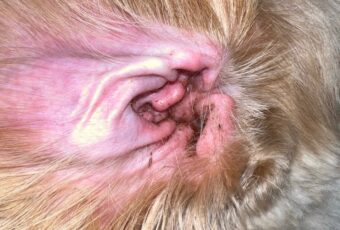Ear Infections in Pets: Causes and Treatments

Background
Ear infections are a relatively common condition in dogs and cats and occur in all age groups. In a study drawing information from nearly 1 million dogs in the UK, 7% of dogs experienced an ear infection annually. The typical ear infection causes inflammation of the ear canal, the tube that carries sound to the eardrum. This inflammation is known as otitis externa because it affects the outer ear. Otitis media and otitis interna affect the middle and inner ear respectively. Middle and inner ear infections are much more serious conditions that can ultimately lead to neurologic signs such as a head tilt or dizziness and loss of hearing.
Otitis externa can have multiple causes, including allergies, bacteria, yeast, parasites (such as ear mites), or foreign bodies.

Risk Factors
Dogs with floppy ears or V-shaped bent ears are more likely to develop ear infections. Dog breeds at risk include:
- Basset hounds
- Beagles
- Cocker spaniels
- German shepherds
- Golden retrievers
- Labradoodles
- Poodles
Allergic skin disease is a common cause of ear infections because the inflamed ear is prone to developing bacterial and yeast infections. Grass awns and other plant material can find its way into the ear canals of dogs with outdoor access, resulting in an ear infection. Young puppies and kittens, as opposed to adults, are most at risk of contracting ear mites. Occasionally, a tumor develops in the ear canal and sets off an infection.
Since dogs and cats have vertical, L-shaped ear canals, the bottom of the canal tends to hold fluid. Activities such as swimming, bathing, or a visit to the groomer’s can also put pets at risk of an ear infection due to the increased moisture in their ears.
Signs
Signs of an ear infection may include:
- Headshaking
- Redness or swelling
- Odor
- Scratching one or both ears
- Increased discharge/wax
- Darkened discharge
- Scaly, crusty, or scabby skin in ears
- Avoiding head petting
Ear infections can occur in one or both ears. Early on, pets may not show signs of an ear infection apart from wax buildup and increased discharge in the ear canal.
Diagnosis
In order to diagnose the underlying cause of an ear infection, your veterinarian will initially review your pet’s medical history and perform a physical examination. The otoscope is a tool that’s used to look closely inside the ear canal. Your veterinarian will use the otoscope to look for any abnormalities, such as signs of inflammation, impacted debris, parasites, or foreign objects. If your pet is in pain, it may be necessary for your veterinarian to sedate your pet in order to properly perform an otoscopic exam.
Your veterinarian may swab the ears to check for any overgrowth of microorganisms or the presence of ear mites using a microscope. They may also want to take a culture of any discharge present to determine if there is a bacterial or yeast infection. There is also the possibility that there are several different types of infections present at the same time.
If allergies are suspected, your veterinarian may treat with allergy medication or may recommend allergy testing for both environmental and dietary causes as 50% of dogs with allergic skin disease and 80% with food sensitivities have some form of ear disease.
If your veterinarian suspects a possible middle or inner ear infection, your pet will need diagnostic imaging (such as a CT scan) to evaluate the middle and inner ear. Middle and inner ear infections may require long-term antibiotics.
Treatment
Your pet’s treatment plan will depend on the underlying cause of infection. Your veterinarian will thoroughly clean your pet’s ears first using a medicated ear cleanser before applying any topical medications. They may also need to remove hair around or within the ear canal beforehand (typically performed under anesthesia).
Topical medications wills be prescribed based on the cause of infection. These may include antibiotics, antifungals, antiparasitics, or glucocorticoids (to reduce pain and swelling). Most cases are resolved within 1 to 2 weeks. It is important to finish the full course of treatment or else your pet is at risk for developing a recurring infection.
Your veterinarian will likely recommend cleaning your pet’s ears before applying any topical medications. It is likely your pet will need daily cleanings while fighting the ear infection. Here are some tips for cleaning your pet’s ears:
- Squirt an animal ear cleaning solution to fill the ear canal
- Massage the base of the ear (you may hear a squishing sound)
- Pull the pinna (outer ear) up and away from the head
- Take a piece of gauze and mold it into a tubular shape. Insert it gently into the ear canal
- Massage the base of the ear again so that the gauze soaks up the moisture and catches any debris. Repeat wiping the ear canal with cotton balls until all debris is removed.
- Wait several minutes before applying any prescribed medications
Most ear infections can be successfully treated with mediations. In some dogs and cats, the ear canal becomes closed off from chronic inflammation or if a tumor develops in the ear. These pets may need a surgery called total ear canal ablation which removes the diseased ear canal and frees the pet from the need for chronic ear cleanings and medication.
Prevention
For dogs with normal ears, monthly cleaning may be all your dog needs. Be careful of cleaning too often as excessive cleaning can lead to ear issues as well. Make sure to keep your pet’s ears dry, and manually dry them after activities such as bathing or swimming. Finally, you should inspect your pet’s ears regularly to note any abnormal changes in appearance or odor. As soon as you notice any changes, make a visit to your veterinarian.
Make an Appointment

Internal Medicine
AMC's board-certified specialists in Internal Medicine treat small animal pets in specialty areas, such as: endocrinology, gastroenterology, hematology, immune-mediated disease, infectious disease, nephrology, reproductive medicine, respiratory medicine, and more.
Learn More





























